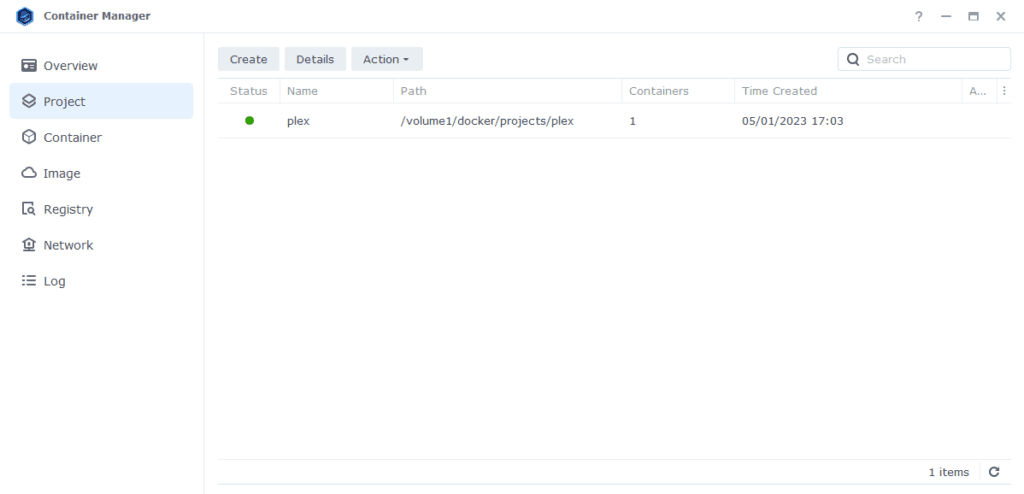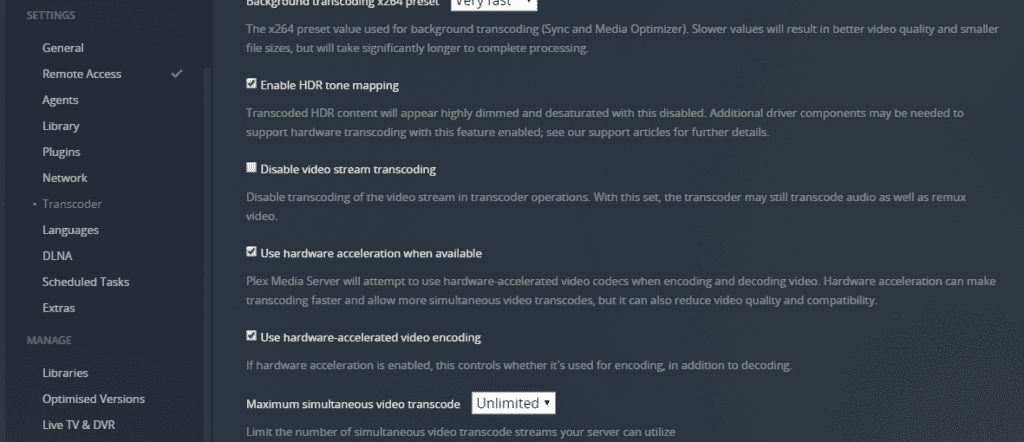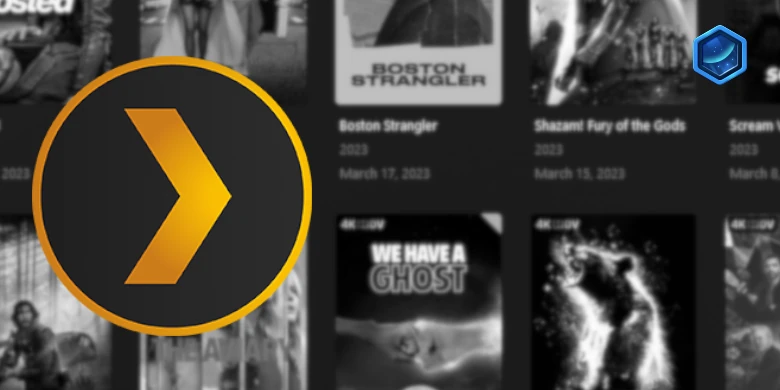Last updated on 30 July 2025
Important or Recent Updates
| Historic Updates | Date |
|---|---|
| New DSM7.2 Container Manager Update | 01/05/2023 |
| Added additional security option to the compose to restrict the container from gaining new privileges as well as umask variable | 25/10/2023 |
| Somehow at some point a paragraph about forwarding port 32400 went missing, I had never added it! But it’s in now!! | 13/06/2024 |
| Changed ‘version’ variable to ‘docker’ this will stop in container server updates! | 01/07/2024 |
In this guide I am going to take you through the setup of Plex in Docker using Container Manager.
Plex Pass
You will only benefit from hardware transcoding if you have an active Plex Pass either monthly or lifetime. If you don’t have one you can either follow this guide or jump over to the non hardware transcoding version.
Does my Synology support Hardware Transcoding?
Before we do anything else, you need to make sure your model of Synology has hardware transcoding capabilities. You need to do a quick lookup via the linked Google Sheet below, this is updated by Plex and makes it super easy to look up your model of NAS.
If you find that hardware transcoding is not available on your model you can jump back over to the standard guide on the menu.
Let’s Begin
As usual, it’s important you complete the two proceeding guides which will get your folder structure and docker, user setup.
Folder Setup
Let’s start by getting some folders set up for the container to use. Open up File Station create the following.
/docker/projects/plex-compose
/docker/plex
Container Manager
Next we are going to set up a ‘Project’ in Container Manager. Open up Container Manager and click on Project then on the right-hand side click ‘Create’.

In the next screen we will set up our General Settings, enter the following:
| Section | Setting |
|---|---|
| Project Name: | plex |
| Path: | /docker/projects/plex-compose |
| Source: | Create docker-compose.yml |
Next we are going to drop in our docker compose configuration copy all the code in the box below and paste it into line ‘1’ just like the screenshot.

services:
plex:
image: linuxserver/plex:latest
container_name: plex
network_mode: host
environment:
- PUID=1234 #CHANGE_TO_YOUR_UID
- PGID=65432 #CHANGE_TO_YOUR_GID
- TZ=Europe/London #CHANGE_TO_YOUR_TZ
- UMASK=022
- VERSION=docker
- PLEX_CLAIM= #Your Plex Claim Code
volumes:
- /volume1/docker/plex:/config
- /volume1/data/media:/data/media
devices:
- /dev/dri:/dev/dri
security_opt:
- no-new-privileges:true
restart: alwaysA note on Network Mode
You will notice that for Plex we don’t put it on the normal bridge network, this is because DSM reserves the DLNA ports Plex requires in order to use DLNA. So we run in Host mode, so it can share the ports.
Environment Variables
We need to make some changes in order for the container to have the correct permissions to save its configuration files and to have access to your media.
| Variable | Value |
|---|---|
| PUID | (required) The UID you obtained in the user setup guide |
| PGID | (required) The GID you obtained in the user setup guide |
| TZ | (required) Your timezone wikipedia.org/wiki/List_of_tz_database_time_zones |
| PLEX_CLAIM | Please note the PLEX_CLAIM variable is optional and not always required. You can remove this line if you don’t need it or come back and add it if you are unable to sign in to your server on start up. To get the code go to https://plex.tv/claim and sign in, then put the code you receive after the ‘PLEX_CLAIM=’. You have 4 mins to finish the guide after doing this, so best to grab it just before running the project. |
Volumes
I have pre-filled this section to pass the correct paths, the only thing that you may need to change is the /volume1/ if your file paths are on a different volume.
Click ‘Next’
You do not need to enable anything on the ‘Web portal settings’ screen click ‘Next’ again.

On the final screen click ‘Done’ which will begin the download of the container images and once downloaded they will be launched!

The image will now be downloaded and extracted. You should see ‘Code 0’ when it has finished.

You will now see your Plex running and should have a green status on the left-hand side.

Firewall Exceptions
(Skip if you don’t have the Firewall configured)
If you have the Synology Firewall enabled please see this additional guide for further info on exceptions and correct set up.
Port Forwarding
In order to use Plex remotely and stream your local media you need to forward port 32400 from your Router to the NAS IP on the same port. This varies for everyone’s router so check the manual on how to do this.
Plex Initial Setup
After a few minutes you should be able to access the server and go through the Plex setup by going to the IP of your NAS in your browser followed by port 32400/web/
e.g. 192.168.0.45:32400/web/
You will be asked to sign in or sign up for an account if you don’t have one already.

You should now be able to add your media which will be in the /data/media folder within Plex

Once you have got to the main Plex interface make sure you go into the settings and turn on
- Enable HDR tone mapping
- Use hardware acceleration when available
- Use hardware-accelerated video encoding

That’s it you are all setup. When a new server update is available you will just need to restart the container, and it will automatically download the latest update.
Looking for some help, join our Discord community
If you are struggling with any steps in the guides or looking to branch out into other containers join our Discord community!
Buy me a beverage!
If you have found my site useful please consider pinging me a tip as it helps cover the cost of running things or just lets me stay hydrated. Plus 10% goes to the devs of the apps I do guides for every year.




So everything apeared tp be working. But I am pretty sure hardware encoding is not working.
It worked when I had it installed outside the pod.
Now when you are off the local network, the CPU hits 99% and the stream doesn’t start.
I read somewhere about giving the pod admin permissions.
Thought?
Hey so you shouldn’t need to grant the container root permissions, when playing something off the network take a look at the Dashboard in Plex and see what status you get for the transcode. Does it have a little ‘hw’ next to the video?
Wow, never knew you could see that there. THANKS.
So after some more digging, I ended up trying someone elses advice suggesting to change max_user_instances and max_user_watches. That SEEMS to have helped. Not sure if it will reset in reboot yet. The transcoading is happening now. I do feel like this is a little janky.
The error I was getting when it tried to transcode was “”error reading output: -5 (I/O error)”. I tried deleting the Cache and Codecs folders and restarting. This all seems like a hack instead of a solution.
I appreciate any ideas.
BTW, this is probably the best tutorial I have ever seen in my years.
Hey not come across this before – however a bit of searching seems to turn up all sorts of fixes which line up with what you have tried.
It may be worth checking permissions a nice way to clean up anything is to run the following which will ensure the dockerlimited user has appropriate permissions on all folders and files. (this assumes you are running Plex as per the guide and is on volume1.)
sudo chown -R dockerlimited:users /volume1/docker/plex /volume1/data
sudo chmod -R a=,a+rX,u+w,g+w /volume1/docker/plex /volume1/data
I attempted to follow this tutorial; however, upon trying to build it, I encountered the error message: “Top-level object must be a mapping.”
Triple check you have not added an extra space or adjusted the formatting at all. I can check it for you if you drop it over https://paste.drfrankenstein.co.uk and post the link here.
Please disregard the previous message. The instructions were effective, and I successfully followed them using a PC.
Oh god, I’ve had my NAS a week and now I want a NUC
Ha – NUCs/MiniPCs are great for offloading the meaty work..
Should this be running on the host network or configured to use the synobridge network?
Hey we set up in host.
Is there a benefit installing Plex as a docker container versus the DSM package that Plex provides?
Two main benefits
1) No issues on a DSM upgrade, if the underlying system changes that breaks the Plex package you will not be down, this has happened a lot over the years.
2) Portability – When your NAS is old, and you want to migrate Plex to something more powerful such as a NUC its lift and drop – copy the files – fire up the container with the same settings. I have done this multiple times as I have Plex on a NUC and moved it through 4 generations NUC6/NUC7/NUC8 and currently a NUC11